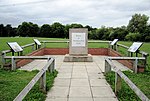Newburn railway station
Disused railway stations in Tyne and WearFormer North Eastern Railway (UK) stationsNorth East England railway station stubsPages with no open date in Infobox stationRailway stations in Great Britain closed in 1958 ... and 3 more
Railway stations in Great Britain opened in 1875Tyne and Wear building and structure stubsUse British English from October 2015

Newburn station was a railway station serving the village of Newburn, Newcastle upon Tyne. The station was situated at the bottom of Station Road, near Newburn Bridge, and was on the Scotswood, Newburn and Wylam Railway, a branch line of the Newcastle and Carlisle Railway.
Excerpt from the Wikipedia article Newburn railway station (License: CC BY-SA 3.0, Authors, Images).Newburn railway station
Newburn Bridge,
Geographical coordinates (GPS) Address Nearby Places Show on map
Geographical coordinates (GPS)
| Latitude | Longitude |
|---|---|
| N 54.981 ° | E -1.744 ° |
Address
Newburn Bridge
Newburn Bridge
NE15 8LR
England, United Kingdom
Open on Google Maps





